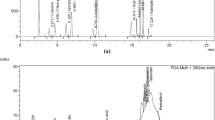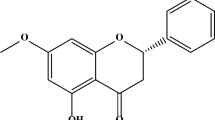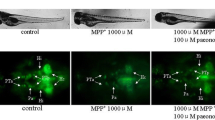Abstract
In an attempt to understand the neuroprotective effect of Fructus Alpinia oxyphylla (AOE) and to elucidate its underlying mechanism of action, the ethanolic extract of AOE was investigated using zebrafish and PC12 cell models. AOE prevented and restored 6-hydroxydopamine (6-OHDA)-induced dopaminergic (DA) neuron degeneration and attenuated a deficit of locomotor activity in a zebrafish (Danio rerio) model of Parkinson’s disease (PD). Treatment with AOE increased the viability of 6-OHDA-treated PC12 cells in vitro in a dose-dependent manner by attenuating cellular apoptosis. However, protocatechuic acid (PCA) and chrysin, two known polyphenol components of AOE, could not reproduce the neuroprotective activity of AOE in the PD zebrafish or PC12 cell models. A mechanistic study found that the protective effect of AOE against 6-OHDA-induced neuronal injury involved anti-inflammatory action (down-regulation of gene expression of IL-1β and TNF-α) and anti-oxidative action (inhibition of NO production and iNOS expression in PC12 cells). Moreover, the PI3K-AKT pathway might be part of the mechanism of neuroprotection of AOE. The results of this research are expected to provide a scientific rationale for the use of AOE in the treatment of PD. However, it is important that the active components that contribute to the neuroprotective action of AOE are identified and characterized.










Similar content being viewed by others
Abbreviations
- AOE:
-
Ethanolic extract of Fructus Alpinia oxyphylla
- PCA:
-
Protocacheuic acid
- F-12K:
-
Kaighn’s modification of Ham’s F12 medium
- MTT:
-
3-(4,5-Dimethyl-thiazol-2-yl)-2,5-diphenyl tetrazolium bromide
- FBS:
-
Fetal bovine serum
- DMSO:
-
Dimethyl sulfoxide
- PBS:
-
Phosphate-buffered saline
- 6-OHDA:
-
6-Hydroxydopamine
- IL-1b:
-
Interleukin 1 beta
- TNF-a:
-
Tumor necrosis factor alpha
- l-NAME:
-
Nω-nitro-l-arginine methyl ester hydrochloride
- SNP:
-
Sodium nitroprusside dehydrate
- CNS:
-
Central nervous system
- PD:
-
Parkinson’s disease
- DA:
-
Dopaminergic
- dpf:
-
Days post fertilization
- nom:
-
Nomifensine
References
Alex D, Leong EC, Zhang ZJ, Yan GT, Cheng SH, Leong CW, Li ZH, Lam KH, Chan SW, Lee SM (2010) Resveratrol derivative, trans-3,5,4′-trimethoxystilbene, exerts antiangiogenic and vascular-disrupting effects in zebrafish through the downregulation of VEGFR2 and cell-cycle modulation. J Cell Biochem 109:339–346
Anichtchik OV, Kaslin J, Peitsaro N, Scheinin M, Panula P (2004) Neurochemical and behavioural changes in zebrafish Danio rerio after systemic administration of 6-hydroxydopamine and 1-methyl-4-phenyl-1,2,3,6-tetrahydropyridine. J Neurochem 88:443–453
Barnham KJ, Masters CL, Bush AI (2004) Neurodegenerative diseases and oxidative stress. Nat Rev Drug Discov 3:205–214
Barthwal MK, Srivastava N, Dikshit M (2001) Role of nitric oxide in a progressive neurodegeneration model of Parkinson’s disease in the rat. Redox Rep 6:297–302
Blum D, Torch S, Lambeng N, Nissou M, Benabid AL, Sadoul R, Verna JM (2001) Molecular pathways involved in the neurotoxicity of 6-OHDA, dopamine and MPTP: contribution to the apoptotic theory in Parkinson’s disease. Prog Neurobiol 65:135–172
Bonfoco E, Krainc D, Ankarcrona M, Nicotera P, Lipton SA (1995) Apoptosis and necrosis: two distinct events induced, respectively, by mild and intense insults with N-methyl-d-aspartate or nitric oxide/superoxide in cortical cell cultures. Proc Natl Acad Sci USA 92:7162–7166
Brunet A, Datta SR, Greenberg ME (2001) Transcription-dependent and -independent control of neuronal survival by the PI3K-Akt signaling pathway. Curr Opin Neurobiol 11:297–305
But PPH (1997) Alpinia oxyphylla. In: But PPH, Kimura T, Guo JX, Sung CK (eds) International collation of traditional and folk medicine: Northeast Asia. Part II. World Scientific, Singapore, pp 1202–1993
Chong ZZ, Li F, Maiese K (2005) Oxidative stress in the brain: novel cellular targets that govern survival during neurodegenerative disease. Prog Neurobiol 75:207–246
Cicchetti F, Brownell AL, Williams K, Chen YI, Livni E, Isacson O (2002) Neuroinflammation of the nigrostriatal pathway during progressive 6-OHDA dopamine degeneration in rats monitored by immunohistochemistry and PET imaging. Eur J Neurosci 15:991–998
Crawford AD, Esguerra CV, de Witte PA (2008) Fishing for drugs from nature: zebrafish as a technology platform for natural product discovery. Planta Med 74:624–632
Dunnett SB, Bjorklund A (1999) Prospects for new restorative and neuroprotective treatments in Parkinson’s disease. Nature 399:A32–A39
Gao HM, Liu B, Zhang W, Hong JS (2003) Synergistic dopaminergic neurotoxicity of MPTP and inflammogen lipopolysaccharide: relevance to the etiology of Parkinson’s disease. FASEB J 17:1957–1959
Guan S, Bao YM, Jiang B, An LJ (2006a) Protective effect of protocatechuic acid from Alpinia oxyphylla on hydrogen peroxide-induced oxidative PC12 cell death. Eur J Pharmacol 538:73–79
Guan S, Jiang B, Bao YM, An LJ (2006b) Protocatechuic acid suppresses MPP+-induced mitochondrial dysfunction and apoptotic cell death in PC12 cells. Food Chem Toxicol 44:1659–1666
Guan S, Ge D, Liu TQ, Ma XH, Cui ZF (2009) Protocatechuic acid promotes cell proliferation and reduces basal apoptosis in cultured neural stem cells. Toxicol In Vitro 23:201–208
Guo S, Bezard E, Zhao B (2005) Protective effect of green tea polyphenols on the SH-SY5Y cells against 6-OHDA induced apoptosis through ROS-NO pathway. Free Radic Biol Med 39:682–695
Hunter RL, Dragicevic N, Seifert K, Choi DY, Liu M, Kim HC, Cass WA, Sullivan PG, Bing G (2007) Inflammation induces mitochondrial dysfunction and dopaminergic neurodegeneration in the nigrostriatal system. J Neurochem 100:1375–1386
Katz NS, Guiard BP, El Mansari M, Blier P (2010) Effects of acute and sustained administration of the catecholamine reuptake inhibitor nomifensine on the firing activity of monoaminergic neurons. J Psychopharmacol (Oxford, England) 24:1223–1235
Klein JA, Ackerman SL (2003) Oxidative stress, cell cycle, and neurodegeneration. J Clin Investig 111:785–793
Koo BS, Lee WC, Chang YC, Kim CH (2004) Protective effects of alpinae oxyphyllae fructus (Alpinia oxyphylla MIQ) water-extracts on neurons from ischemic damage and neuronal cell toxicity. Phytother Res 18:142–148
Lees GJ, Kydd RR, Horsburgh RJ, Wright JJ (1984) Effect of nomifensine on the toxicity of 6-hydroxydopamine for mesotelencephalic dopamine neurons. Brain Res 308:155–158
Li W, Mak M, Jiang H, Wang Q, Pang Y, Chen K, Han Y (2009) Novel anti-Alzheimer’s dimer Bis(7)-cognitin: cellular and molecular mechanisms of neuroprotection through multiple targets. Neurotherapeutics 6:187–201
Lin MT, Beal MF (2006) Mitochondrial dysfunction and oxidative stress in neurodegenerative diseases. Nature 443:787–795
Liu YM, Jiang B, Bao YM, An LJ (2008) Protocatechuic acid inhibits apoptosis by mitochondrial dysfunction in rotenone-induced PC12 cells. Toxicol In Vitro 22:430–437
Livak KJ, Schmittgen TD (2001) Analysis of relative gene expression data using real-time quantitative PCR and the 2(−Delta Delta C(T)) method. Methods 25:402–408
Luthman J, Fredriksson A, Sundstrom E, Jonsson G, Archer T (1989) Selective lesion of central dopamine or noradrenaline neuron systems in the neonatal rat: motor behavior and monoamine alterations at adult stage. Behav Brain Res 33:267–277
Mercer LD, Kelly BL, Horne MK, Beart PM (2005) Dietary polyphenols protect dopamine neurons from oxidative insults and apoptosis: investigations in primary rat mesencephalic cultures. Biochem Pharmacol 69:339–345
Rink E, Wullimann MF (2001) The teleostean (zebrafish) dopaminergic system ascending to the subpallium (striatum) is located in the basal diencephalon (posterior tuberculum). Brain Res 889:316–330
Rodriguez-Blanco J, Martin V, Herrera F, Garcia-Santos G, Antolin I, Rodriguez C (2008) Intracellular signaling pathways involved in post-mitotic dopaminergic PC12 cell death induced by 6-hydroxydopamine. J Neurochem 107:127–140
Shi GF, An LJ, Jiang B, Guan S, Bao YM (2006) Alpinia protocatechuic acid protects against oxidative damage in vitro and reduces oxidative stress in vivo. Neurosci Lett 403:206–210
Sloley BD, Urichuk LJ, Morley P, Durkin J, Shan JJ, Pang PK, Coutts RT (2000) Identification of kaempferol as a monoamine oxidase inhibitor and potential Neuroprotectant in extracts of Ginkgo biloba leaves. J Pharm Pharmacol 52:451–459
Tang JY, Li S, Li ZH, Zhang ZJ, Hu G, Cheang LC, Alex D, Hoi MP, Kwan YW, Chan SW, Leung GP, Lee SM (2010) Calycosin promotes angiogenesis involving estrogen receptor and mitogen-activated protein kinase (MAPK) signaling pathway in zebrafish and HUVEC. PloS one 5:e11822
Wang MW, Zhang ZJ, Cheang LC, Lin ZX, Lee SM (2011) Eriocaulon buergerianum extract protects against 6-hydroxydopamine-induced damage of PC12 cells and neurons in zebrafish. Chin Med 28:16–25
Weinreb O, Amit T, Bar-Am O, Youdim MB (2010) Rasagiline: a novel anti-parkinsonian monoamine oxidase-B inhibitor with neuroprotective activity. Prog Neurobiol 92:330–344
Yu X, An L, Wang Y, Zhao H, Gao C (2003) Neuroprotective effect of Alpinia oxyphylla Miq. fruits against glutamate-induced apoptosis in cortical neurons. Toxicol Lett 144:205–212
Zhang ZJ, Cheang LC, Wang MW, Lee SM (2010) Quercetin exerts a neuroprotective effect through inhibition of the iNOS/NO system and pro-inflammation gene expression in PC12 cells and in zebrafish. Int J Mol Med 27:195–203
Acknowledgments
This work was supported by a grant from the Science and Technology Development Fund of Macau SAR (Ref. No. 045/2007/A3) and the Research Committee, University of Macau (Ref. No. UL017/09-Y1).
Author information
Authors and Affiliations
Corresponding author
Rights and permissions
About this article
Cite this article
Zhang, ZJ., Cheang, L.C.V., Wang, MW. et al. Ethanolic Extract of Fructus Alpinia oxyphylla Protects Against 6-Hydroxydopamine-Induced Damage of PC12 Cells In Vitro and Dopaminergic Neurons in Zebrafish. Cell Mol Neurobiol 32, 27–40 (2012). https://doi.org/10.1007/s10571-011-9731-0
Received:
Accepted:
Published:
Issue Date:
DOI: https://doi.org/10.1007/s10571-011-9731-0




